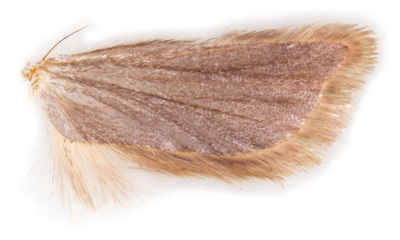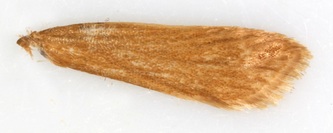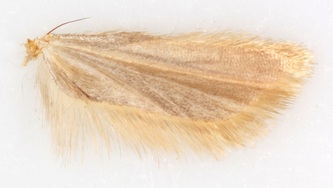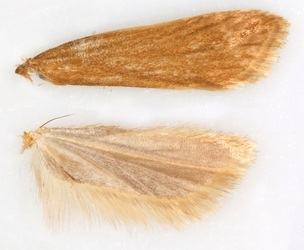35.031 Helcystogramma rufescens (Common Zebra Moth)
ws: 14-18mm; Jul-Aug; grasses; common in grassland in England, Wales and SW Scotland
ID: Similar to H.lutatella which, in Britain, is confined to maritime cliffs in Dorset. According to MBGBI 4.2 and Gelechiid.co.uk: in H.rufescens the forewing is ochreous with veins lined darker, the lateral surface of the labial palps have brown scales and in the female the hindwing is whitish; while in H.lutatella the forewing is grey-brown without lining of the veins, the labial palps are white "above and below" without brown scales and in the female the hindwing is pale to dark grey. The presence of small black stigmata is said to be non-discriminatory, but these seem to be a constant feature of H.lutatella and a variable feature of H.rufescens, so their absence probably rules out H.lutatella. On reviewing web images, it may be more true to say that H.lutatella averages darker, but there is considerable overlap in ground colour; some images labelled H.lutatella do show dark-lined veins. I would also need to examine the labial palps of both species in more detail to determine the usefulness of the absence of brown scaling in identifying H.lutatella and to determine exactly what is meant by 'above and below'. I also have some doubts about the reliability of distinguishing a 'whitish' from a pale grey female hindwing; though a dark grey female hindwing should indicate H.lutatella.
Male genitalia: Both species are illustrated in MBGBI4.2 and shown at Moth Dissection. I am unable to discern any consistent differences between these illustrations and images. The image at Moth Dissection indicates that the shape of a process at the base of the vinculum is important, but the shape of this part is not clear in the Moth Dissection image of H.lutatella and I can perceive no clear difference in the illustrations of this part in MBGBI4.2. The Moth Dissection image of H.lutatella also shows an unlabelled part of the integument of both species, which looks like it might be the first abdominal sclerite - this shows a midline suture in H.lutatella but not in H.rufescens and may show a difference in shape of a sclerotised arc anterior to this. There is a comment that this preparation was used in MBGBI4.2 - but in MBGBI4.2 the equivalent illustration is shown in relation to the female genitalia and does not show the suture - though it does confirm that it is the anterior part of the abdomen we are looking at.
Female genitalia: Both species are illustrated in MBGBI4.2, H.rufescens is shown at Moth Dissection with the comparative image of the anterior part of the abdomen also shown here. It seems to be a feature of the genus that the sclerotisation around the ostium is extended anteriorly on either side of the ostium (and in the lateral image below it looks as though this sclerotisation is reflexed). It looks as though there is a difference between the species in the shape of this sclerotisation - but I need to do more work to determine exactly what the difference is. MBGBI4.2 also shows a more extensive scobinate signum in H.rufescens than in H.lutatella.
Male genitalia: Both species are illustrated in MBGBI4.2 and shown at Moth Dissection. I am unable to discern any consistent differences between these illustrations and images. The image at Moth Dissection indicates that the shape of a process at the base of the vinculum is important, but the shape of this part is not clear in the Moth Dissection image of H.lutatella and I can perceive no clear difference in the illustrations of this part in MBGBI4.2. The Moth Dissection image of H.lutatella also shows an unlabelled part of the integument of both species, which looks like it might be the first abdominal sclerite - this shows a midline suture in H.lutatella but not in H.rufescens and may show a difference in shape of a sclerotised arc anterior to this. There is a comment that this preparation was used in MBGBI4.2 - but in MBGBI4.2 the equivalent illustration is shown in relation to the female genitalia and does not show the suture - though it does confirm that it is the anterior part of the abdomen we are looking at.
Female genitalia: Both species are illustrated in MBGBI4.2, H.rufescens is shown at Moth Dissection with the comparative image of the anterior part of the abdomen also shown here. It seems to be a feature of the genus that the sclerotisation around the ostium is extended anteriorly on either side of the ostium (and in the lateral image below it looks as though this sclerotisation is reflexed). It looks as though there is a difference between the species in the shape of this sclerotisation - but I need to do more work to determine exactly what the difference is. MBGBI4.2 also shows a more extensive scobinate signum in H.rufescens than in H.lutatella.
§1 Foulness, Essex; 28/08/2011; male; fw 8.0mm
§2 Foulness, Essex; 26/08/2007; fw 7.7mm
§3 Sutton Fen, Norfolk; 13/08/2009; fw 7.6mm
§4 Foulness, Essex; 05/08/2012; female
§5 Arne, Dorset; 05/07/2016; male; fw 8.2mm; to light
§6 mortehoe, Devon; 08/07/2020; male; fw 7.5mm
All images © Chris Lewis
§2 Foulness, Essex; 26/08/2007; fw 7.7mm
§3 Sutton Fen, Norfolk; 13/08/2009; fw 7.6mm
§4 Foulness, Essex; 05/08/2012; female
§5 Arne, Dorset; 05/07/2016; male; fw 8.2mm; to light
§6 mortehoe, Devon; 08/07/2020; male; fw 7.5mm
All images © Chris Lewis
Page published 02/11/2011 | §4 (female genitalia) added 01/02/2013 | §5 added and ID text written 15/11/2016 | §6 added 29/01/2021



























